Nobel Science. Feringa, Zernike and the Groningen tradition

26 January until 29 May 2017
Ben Feringa’s prize winning research does not stand on its own. In the long history of the University of Groningen there many scientists who carried out research worthy of a Nobel Prize. Some scientists were so far ahead of their time that others were eventually rewarded for a discovery they had already made.
Nobel Science. Feringa, Zernike and the Groningen tradition brings these – often forgotten – researchers into the limelight and places them next to Ben Feringa’s ‘Nobel Science’.
Researcher like the ‘tinkering headmaster’ Jacobus Laurentius Sirks, who already in 1893 invented a microscope based on the same principles as the one for which Frits Zernike got his Nobel Prize in 1953. Or Hermanus Haga who in 1899 proved the wave-like character of X-rays, thirteen years before Max von Laue who was awarded the Nobel Prize. And what about Willem Kolff who made an artificial kidney from parts of a bomber jet and a T-Ford?
Of course attention is paid to Ben Feringa’s research. What does his research into nano machines entail? How do you make a molecule that you cannot even see? And how will the ‘Groningen tradition’, in which fundamental research is paired to practical applications, develop further?

Extra online exhibition guide
In addition to the exhibition an online guide is available with more extraordinary stories about inventors and scientists from Groningen. You can download this pdf-guide here:
More information
- UK: Impression of the exhibition (short film)
- RUG News: 'Feringa donates Nobel Medal to University Museum'
- NOS: Interview with Ben Feringa (in Dutch)
University of Groningen Videomagazine 'Unifocus':
| Last modified: | 28 April 2022 3.31 p.m. |

